Optimization Study of Glucose Synthesis to 5-Hydroxymethylfurfural (5-HMF) by Using Low Transition-Temperature Mixtures (LTTM)
Abstract
:1. Introduction
2. Results
2.1. Heating of Low Transition Temperature Mixture
2.2. Characterization of LTTM
2.2.1. TGA of Low Transition-Temperature Mixture
2.2.2. Density of LTTM
2.2.3. FTIR Analysis
2.3. Preliminary Study
2.3.1. Product Examination
2.3.2. Effect of Reaction Time and Glucose: LTTM: Water Ratio
2.4. Optimization Study
2.4.1. Sample Observation
2.4.2. Model Fitting
2.4.3. Development of Model
- A = Reaction temperature (°C)
- B = LTTM mass (g)
- C = Water mass (g)
- A = Reaction temperature (°C)
- B = LTTM mass (g)
- C = Water mass (g)
2.4.4. Effect of Independent Variables on 5-HMF Yield
2.4.5. Effect of Independent Variables on Glucose Conversion
2.4.6. Selection of Optimal Level and Estimation of the Optimum Response Characteristics
2.4.7. Identification of Compounds by GC-MS Analysis
2.4.8. Proposed Mechanism
2.5. Insight in 5-HMF Purification
3. Materials and Methods
3.1. Preparation of Starting Materials
3.2. Preparation of LTTM
3.3. LTTM Physical and Chemical Analysis
3.4. Synthesis of 5-HMF
3.5. Design of Experiment
3.6. Quantification of Extraction
3.7. GC-MS Analysis
4. Conclusions
Author Contributions
Funding
Data Availability Statement
Acknowledgments
Conflicts of Interest
References
- Tong, X.; Ma, Y.; Li, Y. Biomass into Chemicals: Conversion of Sugars to Furan Derivatives by Catalytic Processes. Appl. Catal. A Gen. 2010, 385, 1–13. [Google Scholar] [CrossRef]
- Mostapha, M.; Jahar, N.A.; Chin, S.X.; Jaafar, S.N.S.; Zakaria, S.; Aizat, W.M.; Azizan, K.A. Effect of Zeolite Catalyst on Sugar Dehydration for 5-Hydroxymethylfurfural Synthesis. AIP Conf. Proc. 2016, 1784, 040026. [Google Scholar] [CrossRef]
- Rosatella, A.A.; Simeonov, S.P.; Frade, R.F.M.; Afonso, C.A.M. 5-Hydroxymethylfurfural (HMF) as a Building Block Platform: Biological Properties, Synthesis and Synthetic Applications. Green Chem. 2011, 13, 754–793. [Google Scholar] [CrossRef]
- Marianou, A.A.; Michailof, C.M.; Pineda, A.; Iliopoulou, E.F.; Triantafyllidis, K.S.; Lappas, A.A. Effect of Lewis and BrØnsted Acidity on Glucose Conversion to 5-HMF and Lactic Acid in Aqueous and Organic Media. Appl. Catal. A Gen. 2018, 555, 75–87. [Google Scholar] [CrossRef]
- Zhou, L.; Liang, R.; Ma, Z.; Wu, T.; Wu, Y. Conversion of Cellulose to HMF in Ionic Liquid Catalyzed by Bifunctional Ionic Liquids. Bioresour. Technol. 2013, 129, 450–455. [Google Scholar] [CrossRef]
- Guo, F.; Fang, Z.; Zhou, T.J. Conversion of Fructose and Glucose into 5-Hydroxymethylfurfural with Lignin-Derived Carbonaceous Catalyst under Microwave Irradiation in Dimethyl Sulfoxide-Ionic Liquid Mixtures. Bioresour. Technol. 2012, 112, 313–318. [Google Scholar] [CrossRef]
- Osatiashtiani, A.; Lee, A.F.; Granollers, M.; Brown, D.R.; Olivi, L.; Morales, G.; Melero, J.A.; Wilson, K. Hydrothermally Stable, Conformal, Sulfated Zirconia Monolayer Catalysts for Glucose Conversion to 5-HMF. ACS Catal. 2015, 5, 4345–4352. [Google Scholar] [CrossRef]
- Qi, X.; Watanabe, M.; Aida, T.M.; Smith, R.L. Catalytic Conversion of Cellulose into 5-Hydroxymethylfurfural in High Yields via a Two-Step Process. Cellulose 2011, 18, 1327–1333. [Google Scholar] [CrossRef]
- Cukalovic, A.; Stevens, C.V. Production of Biobased HMF Derivatives by Reductive Amination. Green Chem. 2010, 12, 1201–1206. [Google Scholar] [CrossRef]
- Wang, T.; Nolte, M.W.; Shanks, B.H. Catalytic Dehydration of C6 Carbohydrates for the Production of Hydroxymethylfurfural (HMF) as a Versatile Platform Chemical. Green Chem. 2014, 16, 548–572. [Google Scholar] [CrossRef]
- Osatiashtiani, A.; Lee, A.F.; Brown, D.R.; Melero, J.A.; Morales, G.; Wilson, K. Bifunctional SO4/ZrO2 Catalysts for 5-Hydroxymethylfufural (5-HMF) Production from Glucose. Catal. Sci. Technol. 2014, 4, 333–342. [Google Scholar] [CrossRef]
- Ståhlberg, T.; Fu, W.; Woodley, J.M.; Riisager, A. Synthesis of 5-(Hydroxymethyl)Furfural in Ionic Liquids: Paving the Way to Renewable Chemicals. ChemSusChem 2011, 4, 451–458. [Google Scholar] [CrossRef] [PubMed]
- Muranaka, Y.; Matsubara, K.; Maki, T.; Asano, S.; Nakagawa, H.; Mae, K. 5-Hydroxymethylfurfural Synthesis from Monosaccharides by a Biphasic Reaction–Extraction System Using a Microreactor and Extractor. ACS Omega 2020, 5, 9384–9390. [Google Scholar] [CrossRef] [PubMed]
- Ramli, N.A.S.; Amin, N.A.S. A New Functionalized Ionic Liquid for Efficient Glucose Conversion to 5-Hydroxymethyl Furfural and Levulinic Acid. J. Mol. Catal. A Chem. 2015, 407, 113–121. [Google Scholar] [CrossRef]
- Tuteja, J.; Nishimura, S.; Ebitani, K. One-Pot Synthesis of Furans from Various Saccharides Using a Combination of Solid Acid and Base Catalysts. Bull. Chem. Soc. Jpn. 2012, 85, 275–281. [Google Scholar] [CrossRef]
- Zakrzewska, M.E.; Bogel-Łukasik, E.; Bogel-Łukasik, R. Ionic Liquid-Mediated Formation of 5-Hydroxymethylfurfural—A Promising Biomass-Derived Building Block. Chem. Rev. 2011, 111, 397–417. [Google Scholar] [CrossRef] [PubMed]
- Yiin, C.L.; Quitain, A.T.; Yusup, S.; Uemura, Y.; Sasaki, M.; Kida, T. Sustainable Green Pretreatment Approach to Biomass-to-Energy Conversion Using Natural Hydro-Low-Transition-Temperature Mixtures. Bioresour. Technol. 2018, 261, 361–369. [Google Scholar] [CrossRef]
- Martos, M.; Pastor, I.M. Imidazolium-Urea Low Transition Temperature Mixtures for the UHP-Promoted Oxidation of Boron Compounds. J. Mol. Liq. 2022, 347, 118349. [Google Scholar] [CrossRef]
- Istasse, T.; Bockstal, L.; Richel, A. Production of 5-Hydroxymethylfurfural from D-Fructose in Low-Transition-Temperature Mixtures Enhanced by Chloride Anions and Low Amounts of Organic Acids. Chempluschem 2018, 83, 1135–1143. [Google Scholar] [CrossRef]
- Gomes, G.R.; Pastre, J.C. Microwave-Assisted HMF Production from Water-Soluble Sugars Using Betaine-Based Natural Deep Eutectic Solvents (NADES). Sustain. Energy Fuels 2020, 4, 1891–1898. [Google Scholar] [CrossRef]
- Hu, S.; Zhang, Z.; Zhou, Y.; Han, B.; Fan, H.; Li, W.; Song, J.; Xie, Y. Conversion of Fructose to 5-Hydroxymethylfurfural Using Ionic Liquids Prepared from Renewable Materials. Green Chem. 2008, 10, 1280. [Google Scholar] [CrossRef]
- Sert, M.; Arslanoğlu, A.; Ballice, L. Conversion of Sunflower Stalk Based Cellulose to the Valuable Products Using Choline Chloride Based Deep Eutectic Solvents. Renew. Energy 2018, 118, 993–1000. [Google Scholar] [CrossRef]
- Xern, Y. Conversion of Glucose into 5-Hydroxymethylfurfural Using Ultrasonic System in the Presence of Low Transition Temperature Mixture, [Final Year Project]. Unpublish Thesis, Universiti Teknologi PETRONAS, Seri Iskandar, Malaysia, 2019. [Google Scholar]
- Qi, X.; Watanabe, M.; Aida, T.M.; Smith, R.L. Fast Transformation of Glucose and Di-/Polysaccharides into 5-Hydroxymethylfurfural by Microwave Heating in an Ionic Liquid/Catalyst System. ChemSusChem 2010, 3, 1071–1077. [Google Scholar] [CrossRef]
- Dallas Swift, T.; Nguyen, H.; Anderko, A.; Nikolakis, V.; Vlachos, D.G. Tandem Lewis/Brønsted Homogeneous Acid Catalysis: Conversion of Glucose to 5-Hydoxymethylfurfural in an Aqueous Chromium (III) Chloride and Hydrochloric Acid Solution. Green Chem. 2015, 17, 4725–4735. [Google Scholar] [CrossRef]
- Önür, İ.; Misra, N.N.; Barba, F.J.; Putnik, P.; Lorenzo, J.M.; Gökmen, V.; Alpas, H. Effects of Ultrasound and High Pressure on Physicochemical Properties and HMF Formation in Turkish Honey Types. J. Food Eng. 2018, 219, 129–136. [Google Scholar] [CrossRef]
- Yiin, C.L.; Quitain, A.T.; Yusup, S.; Sasaki, M.; Uemura, Y.; Kida, T. Characterization of Natural Low Transition Temperature Mixtures (LTTMs): Green Solvents for Biomass Delignification. Bioresour. Technol. 2016, 199, 258–264. [Google Scholar] [CrossRef]
- Saeed, U.; Laeeq Khan, A.; Amjad Gilani, M.; Roil Bilad, M.; Ullah Khan, A. Supported Liquid Membranes Comprising of Choline Chloride Based Deep Eutectic Solvents for CO2 Capture: Influence of Organic Acids as Hydrogen Bond Donor. J. Mol. Liq. 2021, 335, 116155. [Google Scholar] [CrossRef]
- Al-Risheq, D.I.M.; Nasser, M.S.; Qiblawey, H.; Ba-Abbad, M.M.; Benamor, A.; Hussein, I.A. Destabilization of Stable Bentonite Colloidal Suspension Using Choline Chloride Based Deep Eutectic Solvent: Optimization Study. J. Water Process Eng. 2021, 40, 101885. [Google Scholar] [CrossRef]
- Francisco, M.; González, A.S.B.; García de Dios, S.L.; Weggemans, W.; Kroon, M.C. Comparison of a Low Transition Temperature Mixture (LTTM) Formed by Lactic Acid and Choline Chloride with Choline Lactate Ionic Liquid and the Choline Chloride Salt: Physical Properties and Vapour–Liquid Equilibria of Mixtures Containing Water and Ethanol. RSC Adv. 2013, 3, 23553. [Google Scholar] [CrossRef]
- Francisco, M.; van den Bruinhorst, A.; Kroon, M.C. New Natural and Renewable Low Transition Temperature Mixtures (LTTMs): Screening as Solvents for Lignocellulosic Biomass Processing. Green Chem. 2012, 14, 2153. [Google Scholar] [CrossRef]
- Gutiérrez, M.C.; Ferrer, M.L.; Yuste, L.; Rojo, F.; del Monte, F. Bacteria Incorporation in Deep-Eutectic Solvents through Freeze-Drying. Angew. Chemie Int. Ed. 2010, 49, 2158–2162. [Google Scholar] [CrossRef] [PubMed]
- Shapla, U.M.; Solayman, M.; Alam, N.; Khalil, M.I.; Gan, S.H. 5-Hydroxymethylfurfural (HMF) Levels in Honey and Other Food Products: Effects on Bees and Human Health. Chem. Cent. J. 2018, 12, 35. [Google Scholar] [CrossRef] [PubMed]
- Zhou, C.; Zhao, J.; Yagoub, A.E.A.; Ma, H.; Yu, X.; Hu, J.; Bao, X.; Liu, S. Conversion of Glucose into 5-Hydroxymethylfurfural in Different Solvents and Catalysts: Reaction Kinetics and Mechanism. Egypt. J. Pet. 2017, 26, 477–487. [Google Scholar] [CrossRef]
- Guo, W.; Heeres, H.J.; Yue, J. Continuous Synthesis of 5-Hydroxymethylfurfural from Glucose Using a Combination of AlCl3 and HCl as Catalyst in a Biphasic Slug Flow Capillary Microreactor. Chem. Eng. J. 2020, 381, 122754. [Google Scholar] [CrossRef]
- Mostapha, M. Production of 5-Hydroxymethylfurfural from Oil Palm Trunk Core via Maillard Synthesis and Its Antioxidant Effects. Unpublish Thesis, Universiti Kebangsaan Malaysia, Bangi, Malaysia, 2019. [Google Scholar]
- Mankar, A.R.; Pandey, A.; Modak, A.; Pant, K.K. Microwave Mediated Enhanced Production of 5-Hydroxymethylfurfural Using Choline Chloride-Based Eutectic Mixture as Sustainable Catalyst. Renew. Energy 2021, 177, 643–651. [Google Scholar] [CrossRef]
- Eminov, S.; Brandt, A.; Wilton-Ely, J.D.E.T.; Hallett, J.P. The Highly Selective and Near-Quantitative Conversion of Glucose to 5-Hydroxymethylfurfural Using Ionic Liquids. PLoS ONE 2016, 11, e0163835. [Google Scholar] [CrossRef]
- Jeong, J.; Antonyraj, C.A.; Shin, S.; Kim, S.; Kim, B.; Lee, K.-Y.; Cho, J.K. Commercially Attractive Process for Production of 5-Hydroxymethyl-2-Furfural from High Fructose Corn Syrup. J. Ind. Eng. Chem. 2013, 19, 1106–1111. [Google Scholar] [CrossRef]
- Aellig, C.; Hermans, I. Continuous D-Fructose Dehydration to 5-Hydroxymethylfurfural Under Mild Conditions. ChemSusChem 2012, 5, 1737–1742. [Google Scholar] [CrossRef]
- Xiang, X.; Cui, J.; Ding, G.; Zheng, H.; Zhu, Y.; Li, Y. One-Step Continuous Conversion of Fructose to 2,5-Dihydroxymethylfuran and 2,5-Dimethylfuran. ACS Sustain. Chem. Eng. 2016, 4, 4506–4510. [Google Scholar] [CrossRef]
- Zunita, M.; Wahyuningrum, D.; Bundjali, B.; Wenten, I.G.; Boopathy, R. Conversion of Glucose to 5-Hydroxymethylfurfural, Levulinic Acid, and Formic Acid in 1,3-Dibutyl-2-(2-Butoxyphenyl)-4,5-Diphenylimidazolium Iodide-Based Ionic Liquid. Appl. Sci. 2021, 11, 989. [Google Scholar] [CrossRef]
- Behera, S.K.; Meena, H.; Chakraborty, S.; Meikap, B.C. Application of Response Surface Methodology (RSM) for Optimization of Leaching Parameters for Ash Reduction from Low-Grade Coal. Int. J. Min. Sci. Technol. 2018, 28, 621–629. [Google Scholar] [CrossRef]
- Lewkowski, J. Synthesis, Chemistry and Applications of 5-Hydroxymethyl-Furfural and Its Derivatives. Arkivoc 2001, 2001, 17–54. [Google Scholar] [CrossRef]
- Zhang, H.; Yu, Z.; Gu, T.; Xiang, L.; Shang, M.; Shen, C.; Su, Y. Continuous Synthesis of 5-Hydroxymethylfurfural Using Deep Eutectic Solvents and Its Kinetic Study in Microreactors. Chem. Eng. J. 2020, 391, 123580. [Google Scholar] [CrossRef]
- Villanueva, N.I.; Marzialetti, T.G. Mechanism and Kinetic Parameters of Glucose and Fructose Dehydration to 5-Hydroxymethylfurfural over Solid Phosphate Catalysts in Water. Catal. Today 2018, 302, 100–107. [Google Scholar] [CrossRef]
- Wang, J.; Cui, H.; Wang, J.; Li, Z.; Wang, M.; Yi, W. Kinetic Insight into Glucose Conversion to 5-Hydroxymethyl Furfural and Levulinic Acid in LiCl⋅3H2O without Additional Catalyst. Chem. Eng. J. 2021, 415, 128922. [Google Scholar] [CrossRef]
- Hu, L.; Jiang, Y.; Wu, Z.; Wang, X.; He, A.; Xu, J.; Xu, J. State-of-the-Art Advances and Perspectives in the Separation of Biomass-Derived 5-Hydroxymethylfurfural. J. Clean. Prod. 2020, 276, 124219. [Google Scholar] [CrossRef]
- Esteban, J.; Vorholt, A.J.; Leitner, W. An Overview of the Biphasic Dehydration of Sugars to 5-Hydroxymethylfurfural and Furfural: A Rational Selection of Solvents Using COSMO-RS and Selection Guides. Green Chem. 2020, 22, 2097–2128. [Google Scholar] [CrossRef]
- Slak, J.; Pomeroy, B.; Kostyniuk, A.; Grilc, M.; Likozar, B. A Review of Bio-Refining Process Intensification in Catalytic Conversion Reactions, Separations and Purifications of Hydroxymethylfurfural (HMF) and Furfural. Chem. Eng. J. 2022, 429, 132325. [Google Scholar] [CrossRef]
- Tomer, R.; Biswas, P. Optimization of Reaction Parameters by Using Response Surface Methodology (RSM) for the Selective Dehydration of Glucose to 5-Hydroxymethylfurfural (5-HMF), a Valuable Platform Chemical over a Mesoporous TiO2 Catalyst in Dimethylsulfoxide (DMSO) Medium. Catal. Today 2022, 404, 201–218. [Google Scholar] [CrossRef]
- Scano, P.; Murgia, A.; Pirisi, F.M.; Caboni, P. A Gas Chromatography-Mass Spectrometry-Based Metabolomic Approach for the Characterization of Goat Milk Compared with Cow Milk. J. Dairy Sci. 2014, 97, 6057–6066. [Google Scholar] [CrossRef]
- Omari, K.W.; Besaw, J.E.; Kerton, F.M. Hydrolysis of Chitosan to Yield Levulinic Acid and 5-Hydroxymethylfurfural in Water under Microwave Irradiation. Green Chem. 2012, 14, 1480. [Google Scholar] [CrossRef]


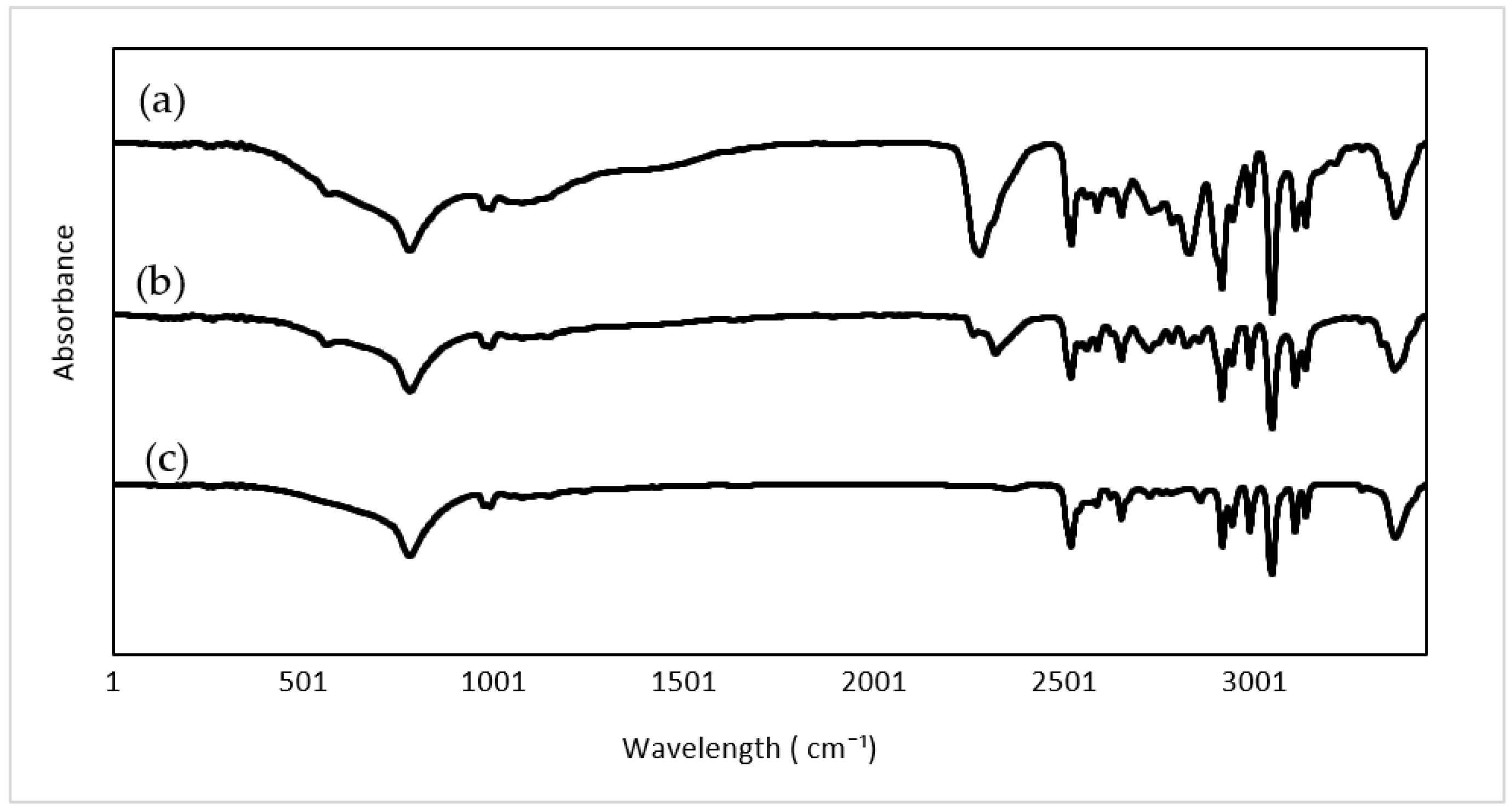
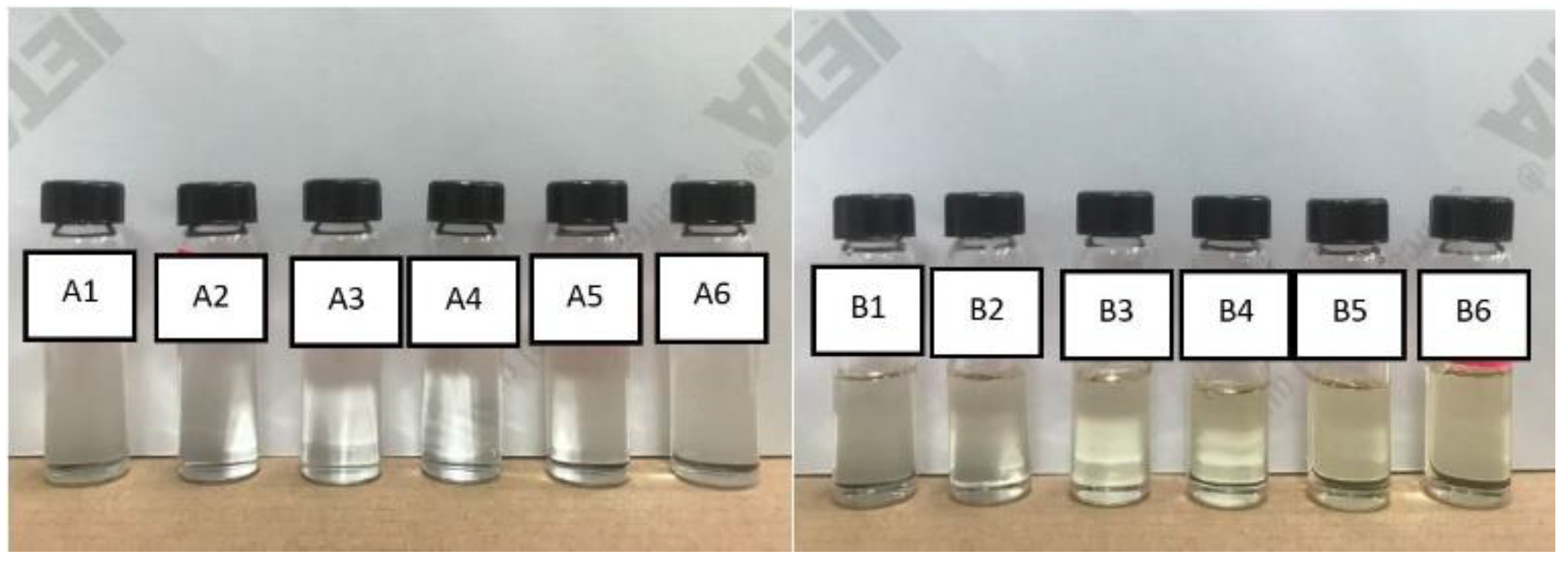
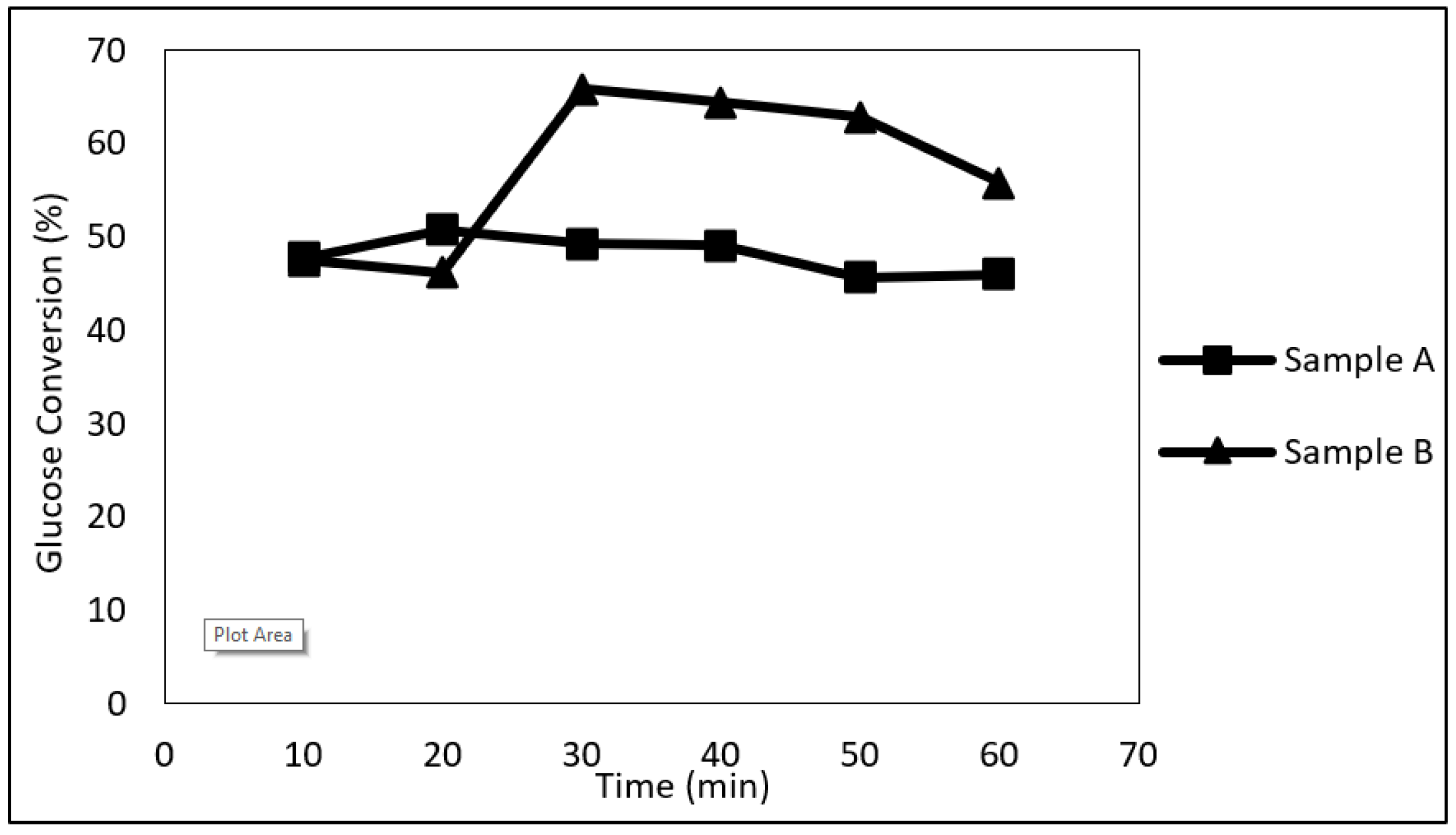

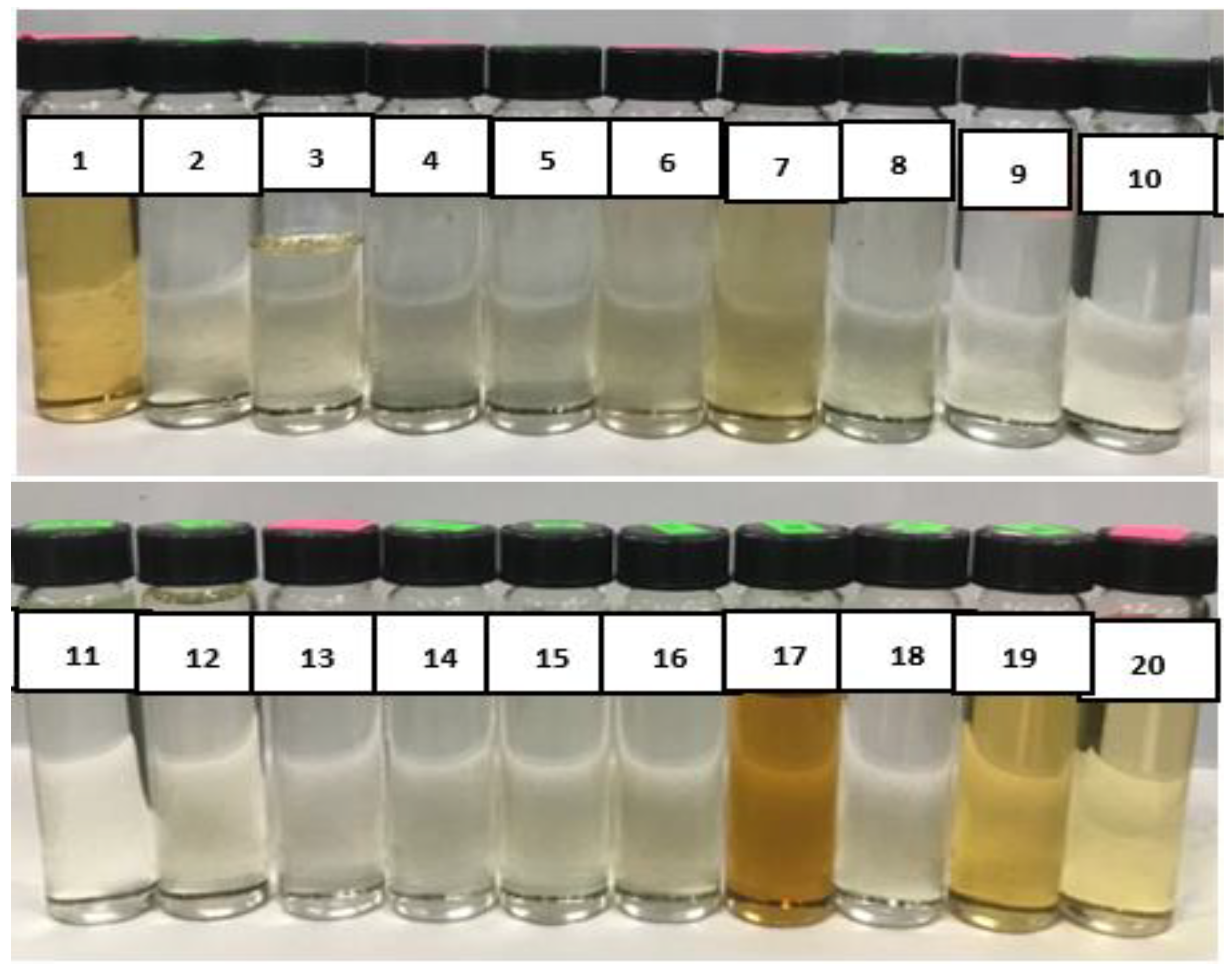

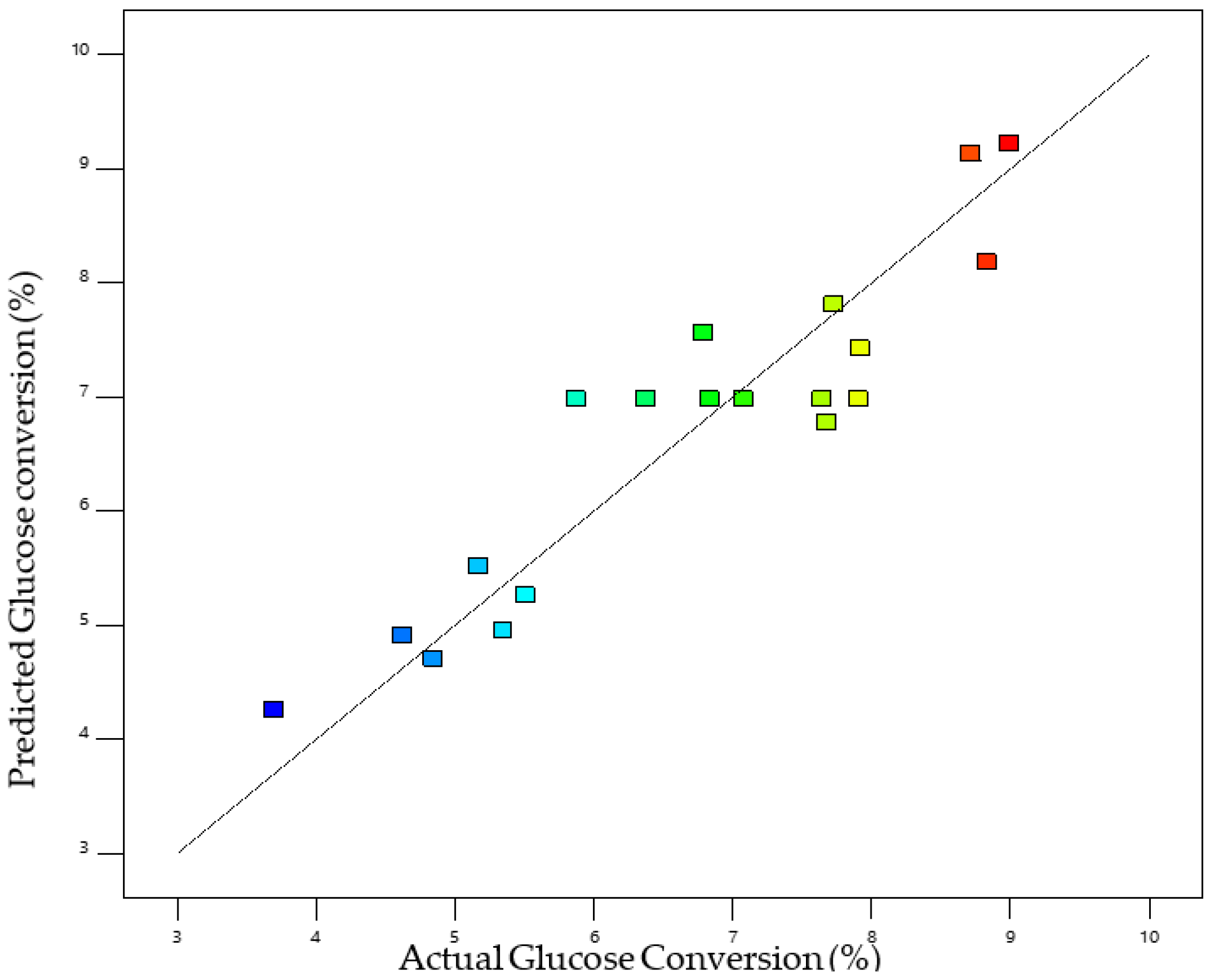
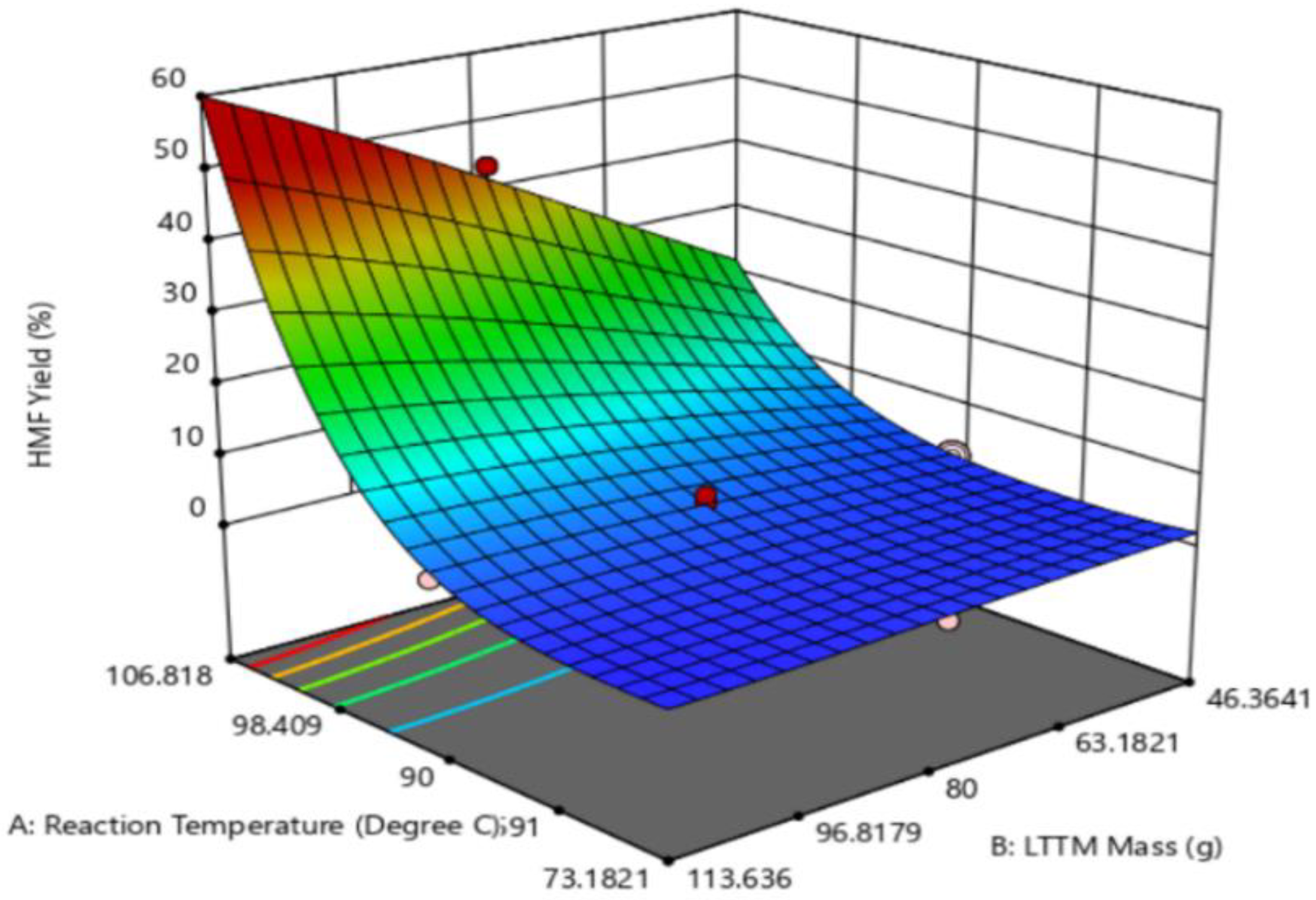
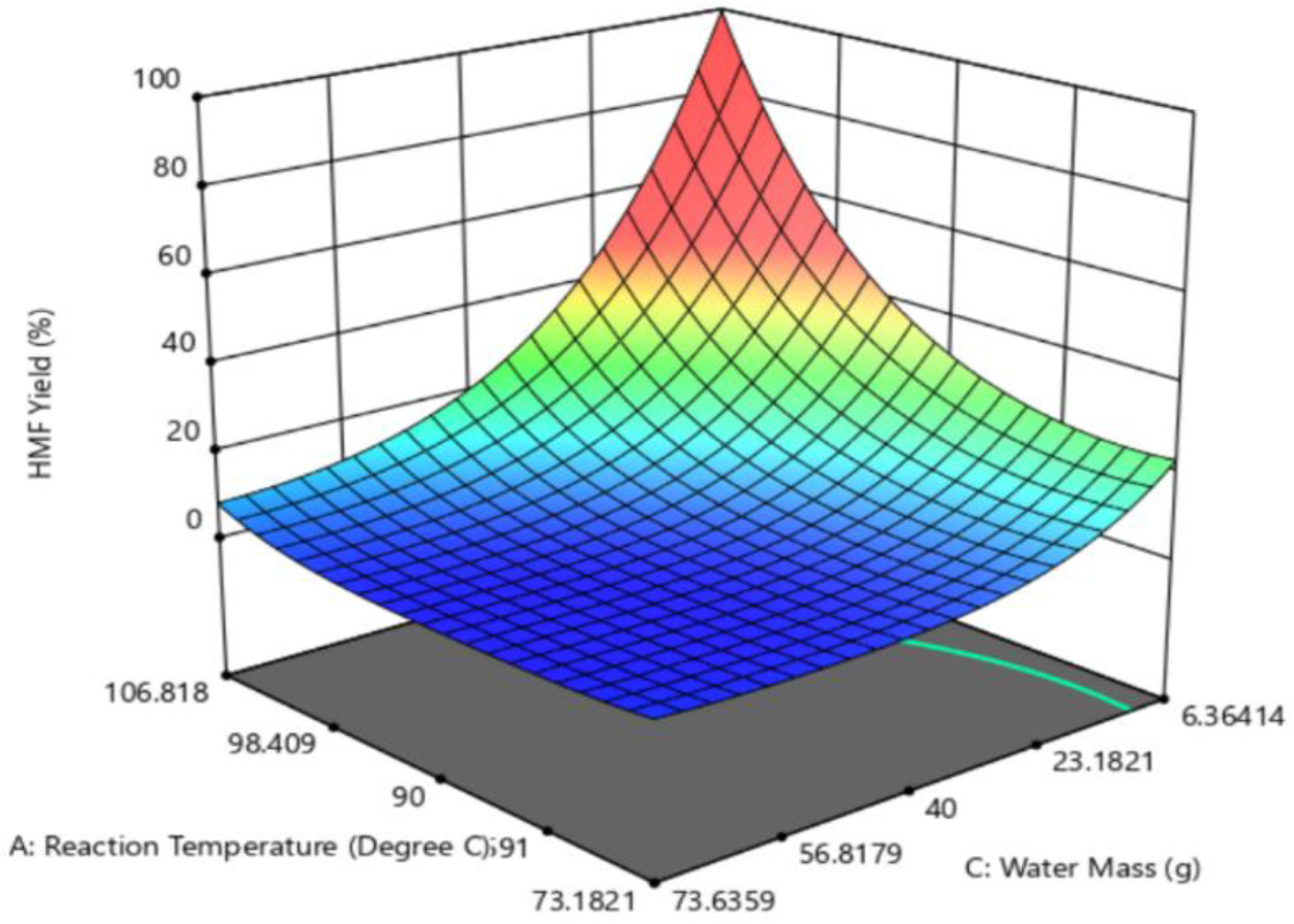

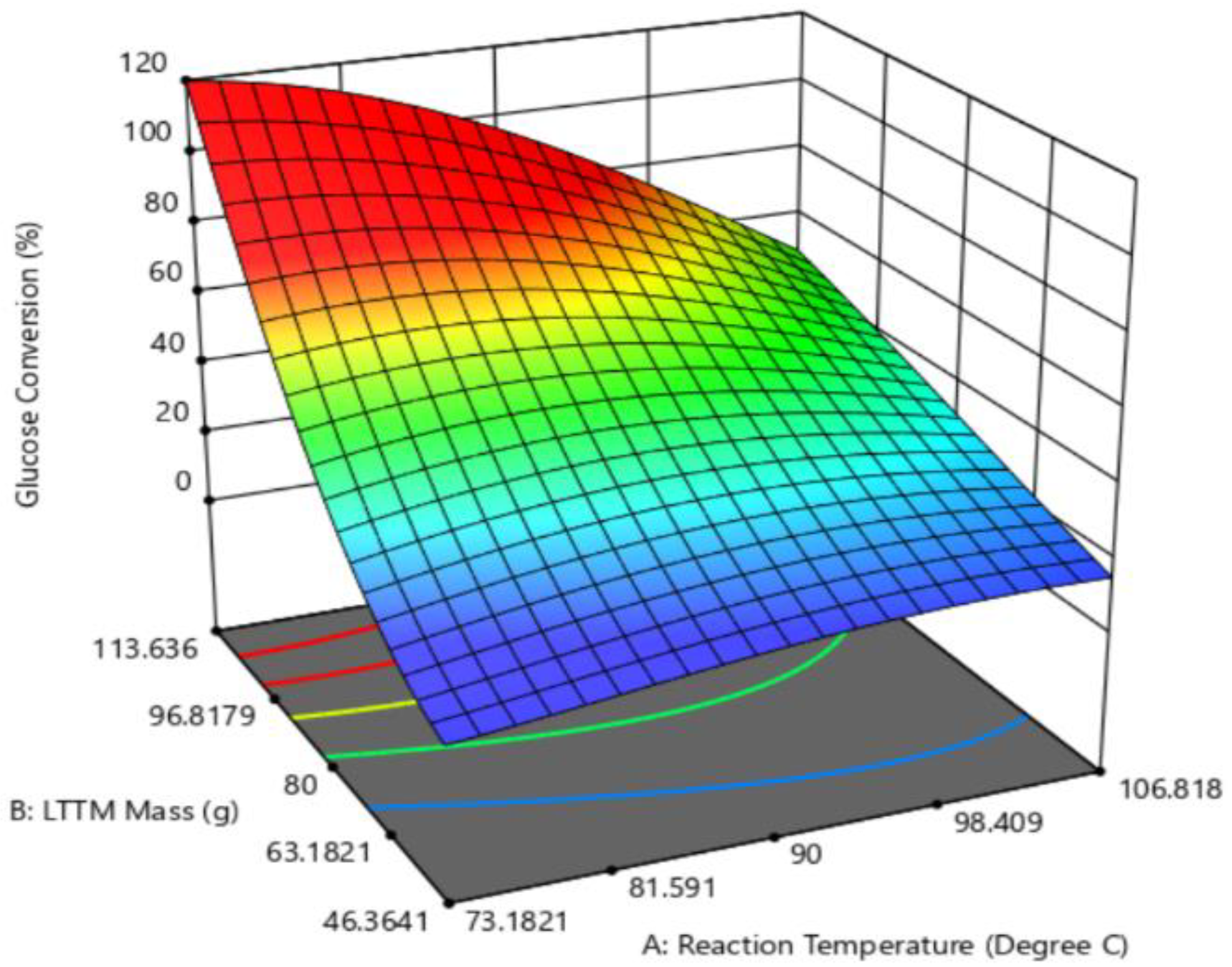

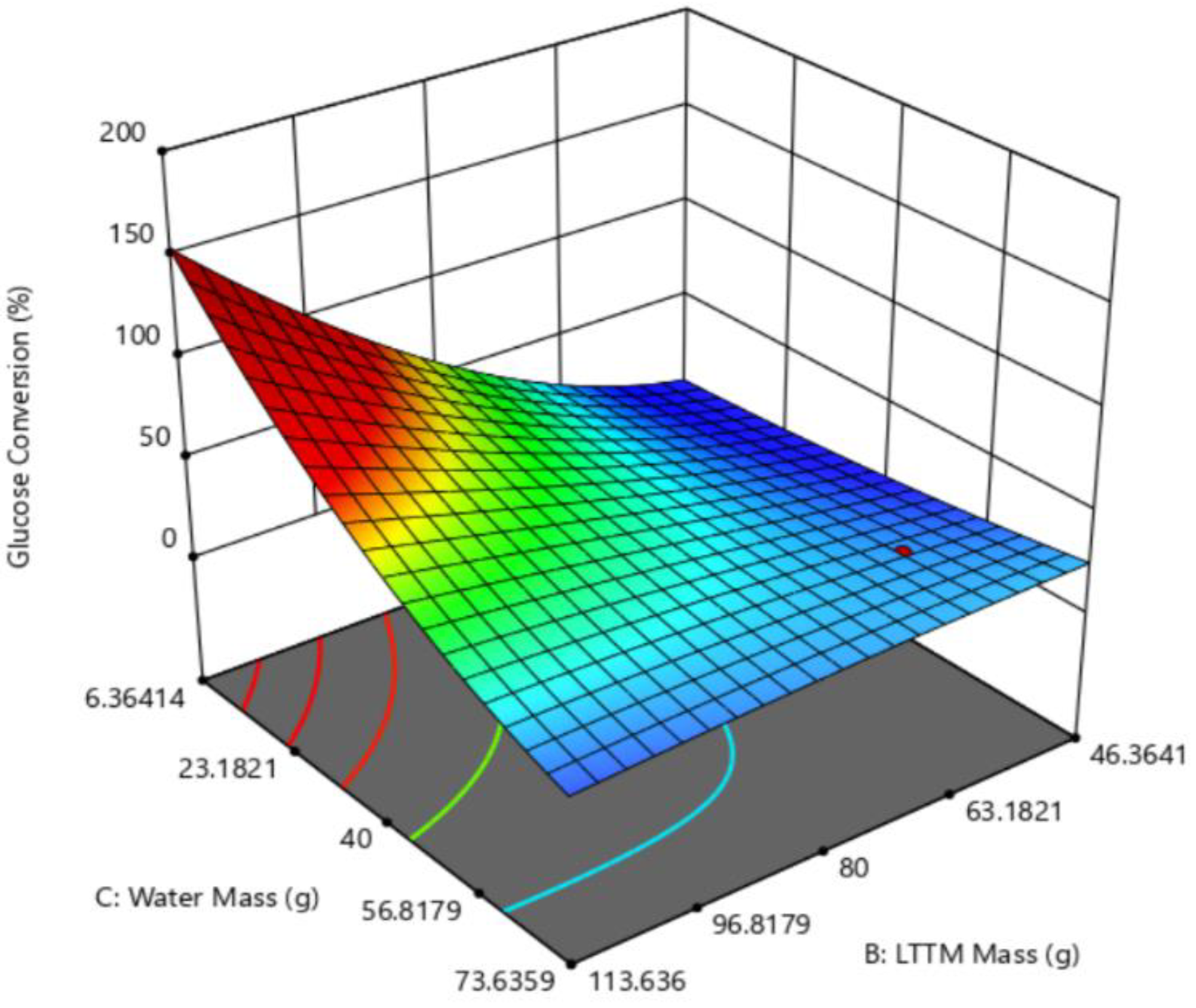

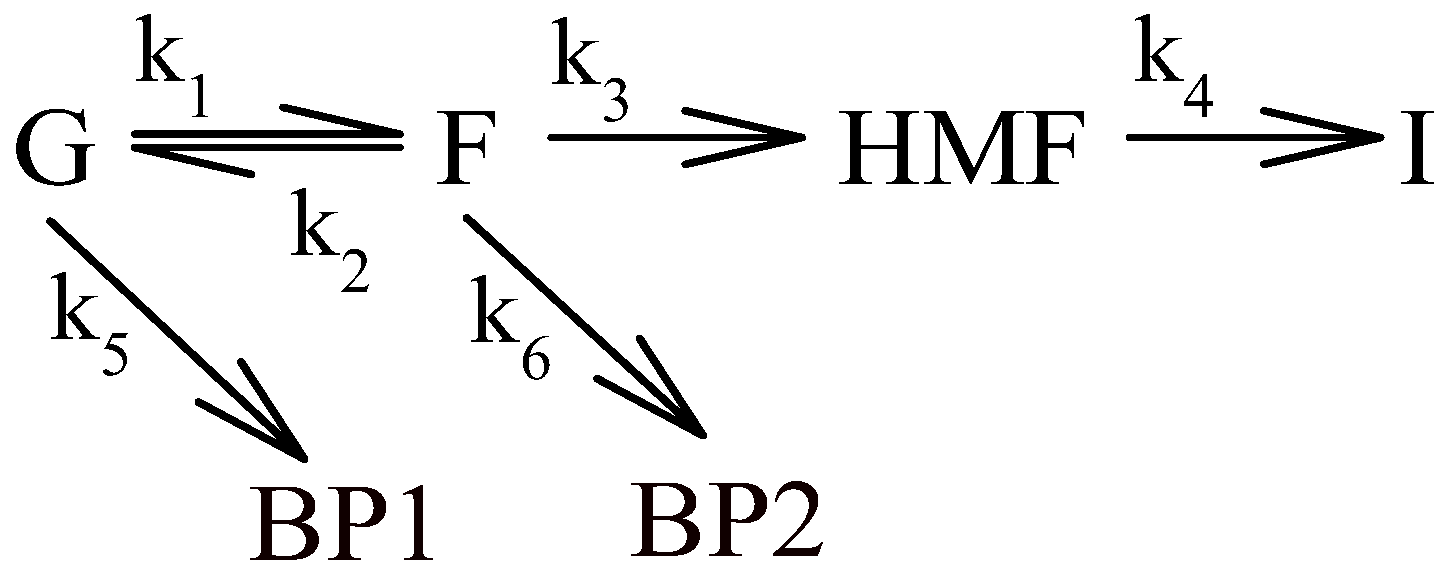
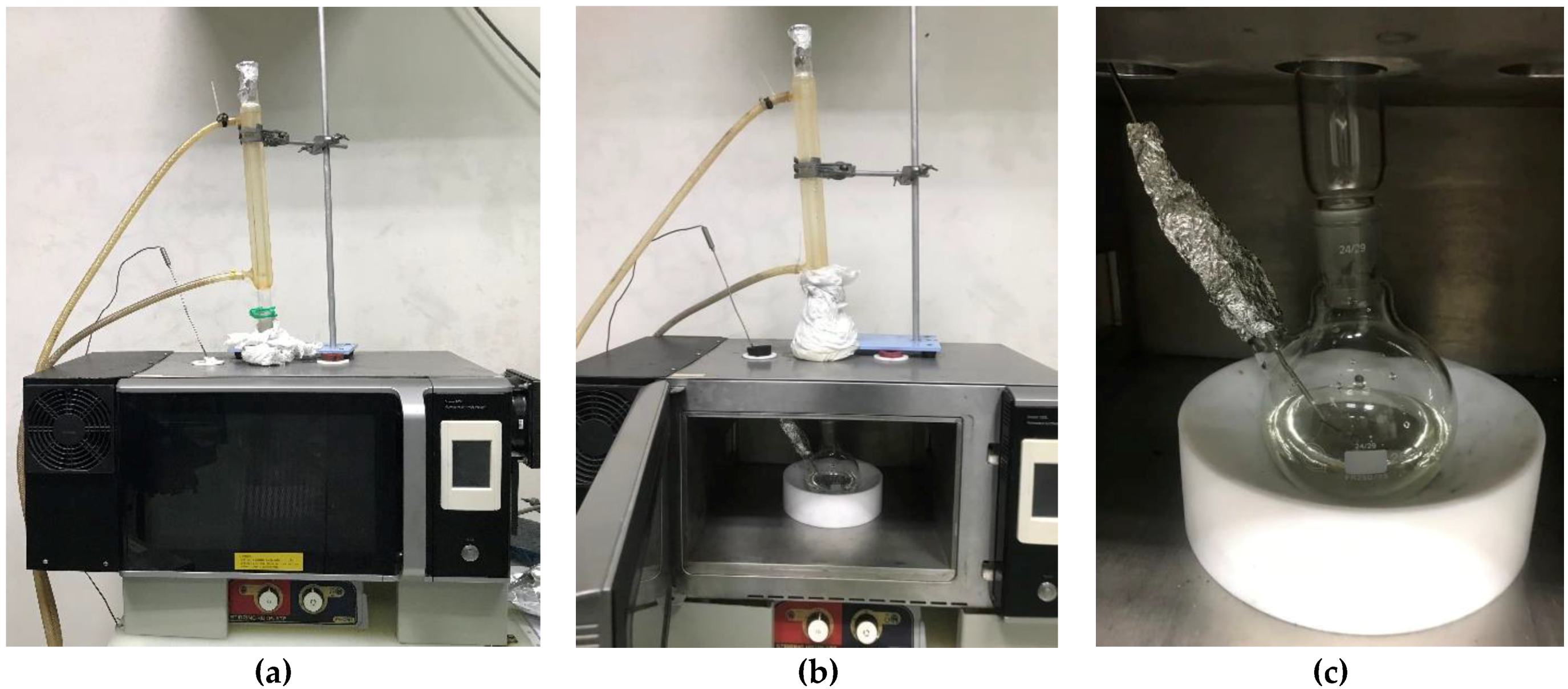
| Sample | Time (min) | Glucose: LTTM: Water Ratio (g) |
|---|---|---|
| A1 | 10 | 10:48:100 |
| A2 | 20 | |
| A3 | 30 | |
| A4 | 40 | |
| A5 | 50 | |
| A6 | 60 | |
| B1 | 10 | 10:100:15 |
| B2 | 20 | |
| B3 | 30 | |
| B4 | 40 | |
| B5 | 50 | |
| B6 | 60 |
| Std | Run | Temperature (°C) | LTTM Mass (g) | Water Mass (g) |
|---|---|---|---|---|
| 4 | 1 | 100 | 100 | 20 |
| 5 | 2 | 80 | 60 | 60 |
| 1 | 3 | 80 | 60 | 20 |
| 17 | 4 | 90 | 80 | 40 |
| 3 | 5 | 80 | 100 | 20 |
| 8 | 6 | 100 | 100 | 60 |
| 10 | 7 | 107 | 80 | 40 |
| 12 | 8 | 90 | 113.64 | 40 |
| 6 | 9 | 100 | 60 | 60 |
| 18 | 10 | 90 | 80 | 40 |
| 14 | 11 | 90 | 80 | 73.63 |
| 15 | 12 | 90 | 80 | 40 |
| 9 | 13 | 73 | 80 | 40 |
| 11 | 14 | 90 | 46.36 | 40 |
| 20 | 15 | 90 | 80 | 40 |
| 16 | 16 | 90 | 80 | 40 |
| 13 | 17 | 90 | 80 | 6.36 |
| 7 | 18 | 80 | 100 | 60 |
| 19 | 19 | 90 | 80 | 40 |
| 2 | 20 | 100 | 60 | 20 |
| Source | Sum of Squares | df | Mean Square | F-Value | p-Value | Remarks |
|---|---|---|---|---|---|---|
| Mean vs. Total | 159.06 | 1 | 159.06 | |||
| Linear vs. Mean | 60.37 | 3 | 20.12 | 24.85 | <0.0001 | |
| 2FI vs. Linear | 2.28 | 3 | 0.7590 | 0.9237 | 0.4568 | |
| Quadratic vs. 2FI | 9.66 | 3 | 3.22 | 31.68 | <0.0001 | Suggested |
| Cubic vs. Quadratic | 0.6151 | 4 | 0.1538 | 2.30 | 0.1736 | Aliased |
| Residual | 0.4017 | 6 | 0.0670 | |||
| Total | 232.39 | 20 | 11.62 |
| Source | Sum of Squares | df | Mean Square | F-Value | p-Value | Remarks |
|---|---|---|---|---|---|---|
| Mean vs. Total | 856.61 | 1 | 856.61 | |||
| Linear vs. Mean | 17.82 | 3 | 5.94 | 3.52 | 0.0412 | |
| 2FI vs. Linear | 18.19 | 3 | 6.06 | 10.23 | 0.0013 | Suggested |
| Quadratic vs. 2FI | 1.12 | 3 | 0.3730 | 0.5601 | 0.6546 | |
| Cubic vs. Quadratic | 3.08 | 4 | 0.7696 | 1.32 | 0.3770 | Aliased |
| Residual | 2.92 | 5 | 0.5833 | |||
| Total | 899.74 | 19 | 47.35 |
| Source | Sum of Squares | df | Mean Square | F-Value | p-Value | Remarks |
|---|---|---|---|---|---|---|
| Model | 72.31 | 9 | 8.03 | 79.01 | <0.0001 | significant |
| A—Reaction temperature | 36.78 | 1 | 36.78 | 361.75 | <0.0001 | |
| B—LTTM mass | 0.9272 | 1 | 0.9272 | 9.12 | 0.0129 | |
| C—Water mass | 22.66 | 1 | 22.66 | 222.80 | <0.0001 | |
| AB | 1.19 | 1 | 1.19 | 11.69 | 0.0066 | |
| AC | 0.8610 | 1 | 0.8610 | 8.47 | 0.0156 | |
| BC | 0.2274 | 1 | 0.2274 | 2.24 | 0.1657 | |
| A² | 4.71 | 1 | 4.71 | 46.33 | <0.0001 | |
| B² | 0.1077 | 1 | 0.1077 | 1.06 | 0.3277 | |
| C² | 5.31 | 1 | 5.31 | 52.22 | <0.0001 | |
| Residual | 1.02 | 10 | 0.1017 | |||
| Lack of fit | 0.7898 | 5 | 0.1580 | 3.48 | 0.0988 | not significant |
| Pure error | 0.2271 | 5 | 0.0454 | |||
| Cor total | 73.33 | 19 | ||||
| Std. dev | 0.3189 | Adjusted R2 | 0.9737 | |||
| Mean | 2.82 | Predicted R2 | 0.9089 | |||
| R2 | 0.9861 | Adeq precision | 28.2925 |
| Source | Sum of Squares | df | Mean Square | F-Value | p-Value | Remarks |
|---|---|---|---|---|---|---|
| Model | 37.14 | 9 | 4.13 | 6.20 | 0.0061 | significant |
| A—Reaction temperature | 7.40 | 1 | 7.40 | 11.11 | 0.0088 | |
| B—LTTM mass | 10.27 | 1 | 10.27 | 15.42 | 0.0035 | |
| C—Water mass | 0.2752 | 1 | 0.2752 | 0.4131 | 0.5364 | |
| AB | 2.48 | 1 | 2.48 | 3.72 | 0.0859 | |
| AC | 7.45 | 1 | 7.45 | 11.19 | 0.0086 | |
| BC | 8.26 | 1 | 8.26 | 12.41 | 0.0065 | |
| A² | 1.08 | 1 | 1.08 | 1.62 | 0.2345 | |
| B² | 0.1156 | 1 | 0.1156 | 0.1736 | 0.6867 | |
| C² | 0.0094 | 1 | 0.0094 | 0.0141 | 0.9080 | |
| Residual | 5.99 | 9 | 0.6661 | |||
| Lack of fit | 3.08 | 4 | 0.7696 | 1.32 | 0.3770 | not significant |
| Pure error | 2.92 | 5 | 0.5833 | |||
| Cor total | 43.13 | 18 | ||||
| Std. dev | 0.8161 | Adjusted R2 | 0.7220 | |||
| Mean | 6.71 | Predicted R2 | 0.1936 | |||
| R2 | 0.8610 | Adeq precision | 8.3917 |
| No | Compound | Area (%) | Retention Time (min) (RT) |
|---|---|---|---|
| 1 | N,N-Dimethylaminoethanol | 21.015 | 6.841 |
| 2 | 5-Hydroxymethylfurfural | 17.208 | 5.826 |
| 3 | Acetamide, 2,2,2-trifluoro-N-methyl | 13.130 | 2.317 |
| 4 | Maleic anhydride | 10.609 | 3.439 |
| 5 | 2-Propenoic acid | 10.374 | 6.431 |
| 6 | 1,3-Dioxolan-4-on-5-acetic acid, -trichloromethyl- | 8.516 | 6.593 |
| 7 | Dimethyl fumarate | 7.576 | 4.536 |
| 8 | 2-Propenoic acid, 2-(dimethylamino)ethyl ester | 6.811 | 8.272 |
| 9 | 6-Pentadecanone | 4.275 | 5.217 |
| 10 | 3-Acetoxy-3-hydroxypropionic acid, methyl ester | 4.292 | 7.208 |
| 11 | Chloroacetic acid, 4-methoxy-2-methylbutyl ester | 4.074 | 7.457 |
| 12 | Fumaric acid | 2.380 | 6.932 |
| 13 | Propanenitrile, 3-(dimethylamino) | 2.110 | 4.139 |
| 14 | Carbonic acid | 2.692 | 7.839 |
| 15 | Propanenitrile, 3-(ethylamino)- | 1.001 | 5.994 |
| 16 | N-Methylhomopiperazine | 0.810 | 3.545 |
| 17 | 2-(Ethylamino)ethanol, N,O-diacety | 0.529 | 8.488 |
| 18 | Ethanamine, 2-chloro-N,N-dimethyl- | 0.334 | 2.923 |
| Reaction Parameters | Type | Low | High |
|---|---|---|---|
| Reaction temperature (°C) | Factor A | 80 | 100 |
| Mass of LTTM (g) | Factor B | 60 | 100 |
| Mass of water (g) | Factor C | 20 | 60 |
| 5-HMF yield (%) | Response A | ||
| Glucose conversion (%) | Response B |
Disclaimer/Publisher’s Note: The statements, opinions and data contained in all publications are solely those of the individual author(s) and contributor(s) and not of MDPI and/or the editor(s). MDPI and/or the editor(s) disclaim responsibility for any injury to people or property resulting from any ideas, methods, instructions or products referred to in the content. |
© 2023 by the authors. Licensee MDPI, Basel, Switzerland. This article is an open access article distributed under the terms and conditions of the Creative Commons Attribution (CC BY) license (https://creativecommons.org/licenses/by/4.0/).
Share and Cite
Abdul Manaf, A.S.; Mostapha, M.; Ameen, M.; Yusup, S.; Amran, N.A. Optimization Study of Glucose Synthesis to 5-Hydroxymethylfurfural (5-HMF) by Using Low Transition-Temperature Mixtures (LTTM). Catalysts 2023, 13, 829. https://doi.org/10.3390/catal13050829
Abdul Manaf AS, Mostapha M, Ameen M, Yusup S, Amran NA. Optimization Study of Glucose Synthesis to 5-Hydroxymethylfurfural (5-HMF) by Using Low Transition-Temperature Mixtures (LTTM). Catalysts. 2023; 13(5):829. https://doi.org/10.3390/catal13050829
Chicago/Turabian StyleAbdul Manaf, Aida Syafiqah, Marhaini Mostapha, Mariam Ameen, Suzana Yusup, and Nurul Aini Amran. 2023. "Optimization Study of Glucose Synthesis to 5-Hydroxymethylfurfural (5-HMF) by Using Low Transition-Temperature Mixtures (LTTM)" Catalysts 13, no. 5: 829. https://doi.org/10.3390/catal13050829







